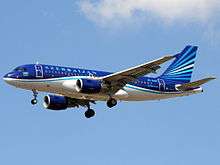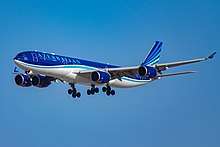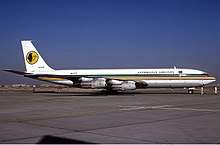Azerbaijan Airlines
 | |||||||
| |||||||
| Founded | 7 April 1992 | ||||||
|---|---|---|---|---|---|---|---|
| Hubs | Heydar Aliyev International Airport | ||||||
| Frequent-flyer program | AZAL Miles | ||||||
| Subsidiaries | Buta Airways | ||||||
| Fleet size | 20 | ||||||
| Destinations | 36 | ||||||
| Headquarters | Baku, Azerbaijan | ||||||
| Key people |
| ||||||
| Employees | ~800 | ||||||
| Website |
www | ||||||
Azerbaijan Airlines (Azerbaijani: Azərbaycan Hava Yolları), also known as AZAL, is the flag carrier and largest airline of the country of Azerbaijan. Based in Baku, adjacent to Heydar Aliyev International Airport, the carrier operates to destinations across Asia, the CIS, Europe and the USA. Azerbaijan Airlines is a member of the International Air Transport Association. The airline was founded on 7 April 1992 as the first national airline established after the country gained its independence.
History
In April 1992, after gaining independence, a state aviation body - State Concern Azerbaijan Airlines (Azərbaycan Hava Yolları) was established by the decision of the government of the Republic of Azerbaijan.
In 1996, Azeraeronavigation Air Traffic Control Center was established as part of the State Concern Azerbaijan Airlines.
In 1997, AZALOIL was established as part of Azerbaijan Airlines.
In 1999, a new international terminal was opened at Baku airport.
In 2000, Azerbaijan Airlines received the first Boeing 757-200 aircraft.
In 2004, by the decision of President Ilham Aliyev, "Bina" Airport in Baku was named "Heydar Aliyev International Airport".
In 2004, the airport in the city of Nakhchivan received the status of international air hub.
In 2005, a new cargo terminal (Baku Cargo Terminal) was opened at Heydar Aliyev International Airport.
In April 2008, by the Order of the President of the Republic of Azerbaijan the state concern AZAL was reorganized into “Azerbaijan Airlines” CJSC.
In 2009, airports in Zaqatala and Lankaran received international status after major reconstruction.
In 2011, Azerbaijan Airlines received the European service standard from the European Economic Chamber of Trade, Commerce and Industry (EEIG).
In 2011, the fleet of Azerbaijan Airlines replenished with Boeing 767-300ER aircraft.
In 2013, Azerbaijan Airlines received Airbus A340-500 long-haul passenger aircraft.
In 2013, “Azalagro” Airline Company was opened in Yevlakh.
In 2014 the new airport terminal of Heydar Aliyev International Airport (Terminal 1) was put into operation.
In 2014, the fleet of Azerbaijan Airlines replenished with Boeing 787-8 Dreamliner aircraft.
In 2014, the fleet of Azerbaijan Airlines replenished with jet aircraft from Brazilian manufacturer Embraer 190 and Embraer 170 transferred in 2017 to a subsidiary low-cost airline “Buta Airways”.
In 2014, Azerbaijan Airlines began to carry out regular transatlantic flights from Baku to New York.
In 2015, British consulting company Skytrax awarded Azerbaijani national carrier with prestigious “4 stars” rating[1].
In 2016, Azerbaijan signed the Open Skies agreement with the United States of America.
In 2016, the first low-cost airline “Buta Airways” was established as a part of AZAL CJSC on the basis of the fleet of Embraer aircraft[2].
In 2018, Skytrax named the airline the “Best Regional Airline” in Central Asia and India[3].
Destinations
Codeshare agreements
Azerbaijan Airlines codeshares with the following airlines:[4]
Fleet


.jpg)
Current fleet
The Azerbaijan Airlines fleet consists of the following aircraft (as of August 2018):
| Aircraft | In service | Orders | Passengers | Notes | |||
|---|---|---|---|---|---|---|---|
| C | Y+ | Y | Total | ||||
| Airbus A319-100 | 4 | — | 8 | — | 114 | 122[5] | |
| Airbus A320-200 | 7 | — | 20 | — | 126 | 146[6] | |
| Airbus A340-500 | 2 | — | 36 | — | 201 | 237[7] | |
| Boeing 737 MAX 8 | — | 10 | Deliveries to begin in November 2018[8] | ||||
| Boeing 757-200 | 3 | — | 24 | — | 150 | 174[9] | |
| 22 | 158 | 180[9] | |||||
| Boeing 767-300ER | 2 | — | 22 | — | 176 | 198[10] | |
| Boeing 787-8 | 2 | 5 | 18 | 35 | 157 | 210[11] | |
| Total | 20 | 15 | |||||
Historical fleet

.jpg)
Azerbaijan Airlines used to operate a number of aircraft, its most common aircraft used to be the Tupolev TU154 until it was retired in 2013. All the aircraft Azerbaijan Airlines used to operate are listed below.
| Aircraft | Fleet | Introduced | Retired | Notes | Refs |
|---|---|---|---|---|---|
| ATR 42-500 | 2 | 2007 | 2013 | ||
| ATR 72-200 | 4 | 2007 | 2013 | ||
| Boeing 707-300 | 6 | 1994 | 1998 | [12] | |
| Boeing 727-200 | 6 | 1993 | 2004 | One fleet is currently stored | [12] |
| Canadair CL-44 | 2 | 1997 | 1998 | [12] | |
| Embraer 170 | 1 | 2013 | 2017 | Transferred to wholly owned subsidiary Buta Airways | |
| Embraer 190 | 6 | 2013 | 2017 | Transferred to wholly owned subsidiary Buta Airways | |
| Ilyushin IL-76 | 7 | 1993 | 2004 | One Aircraft stored at Baku | [12] |
| Tupolev Tu-134 | 21 | 1993 | 2003 | One aircraft still operates for Azerbaijani Government One fleet was written off as Azerbaijan Airlines Flight 56 |
[12] |
| Tupolev Tu-154M | 32 | 1991 | 2013 | One aircraft still operates for Azerbaijani Government | [12] |
Accidents and incidents
- On 30 November 1995, at about 19:10 LT, a Boeing 707-323C, which was registered as 4K-401, was en route from Urumqi (URC), but encountered some problems with the left main landing gear. After a low pass over Baku's runway, the aircraft made a left turn in preparation for landing at the airport. Shortly afterwards, however, the plane struck light stanchions on a road bridge and crashed into a field, killing two crew members and injuring four other people.[13]
- On 5 December 1995, Azerbaijan Airlines Flight 56 was on a return flight between Baku and Nakhchivan. The flight departed Baku at 15:28, arriving at Nakhchivan at 16:37 after an uneventful flight. The plane was refueled and prepared for the flight back to Baku, and departed at 17:52. While climbing through a height of 60 meters after takeoff and at an airspeed of 317 km/h, the no. 1 engine failed. The co-pilot reacted by countering the left bank. The captain then assumed control of the airplane. Because the co-pilot had countered the left bank, the captain did not have the sensory information which could have alerted him that it was the left-hand engine that had failed. The airplane continued to climb through 140m, passing through a layer of smog, after which the captain ordered the right-hand engine to be shut down. The flight engineer noticed that the power on the operating engine was decreasing. He brought the throttle back to the original position, but the engine had already stopped. Eight seconds later, the flight engineer reported that both engines had failed. The airplane had reached an elevation of 197 m and the speed had decreased to 290 km/h. The captain then decided to carry out a forced landing. The plane was then maneuvered for a forced landing during which a sharp right turn was made to avoid an apartment block. In a 37-degree right bank with a 10 m/s (1960 feet/min) descent rate, the airplane crashed into a field in the southwestern outskirts Nakhchivan, 3,850 m from the runway, killing 2 crew members and 50 passengers; 30 were injured. Investigation revealed that, following the mechanical failure of the left-hand engine, the crew shut down the working right-hand engine. The Tu-134B flight deck ergonomics contributed in that the flight engineers' engine parameters are difficult to monitor in conditions of weak illumination. It was later concluded that the engine failed because it was operated for more than 30 hours with an unrepaired defect.[14]
- On 15 May 1997, a number of Azerbaijani soldiers were returning to camp near Ganja after a small arms practice and had begun shooting at a road sign. At the same time a Yakovlev 40 4K-87504 was returning from a training flight and was above the area on its approach to Ganja Airport. A number of stray bullets struck the Yak-40 and hit an oxygen cylinder. A fire broke out and control was lost. The aircraft crashed 5160m short of the runway, 95m left of the extended centerline. All 6 crew members died.[15]
- On 18 August 2000, a passenger hijacked Azerbaijan Airlines Flight 154, a Tupolev Tu-154, while the plane was on a domestic trip between Nakhichevan and Baku. The hijacker claimed to be armed with a hand grenade and a bottle of flammable liquid. He demanded that the aircraft, which was carrying 164 passengers, be flown to Istanbul, Turkey, where he wanted to visit a hospitalized Azeri political leader. The hijacker agreed to the pilot's recommendation to refuel in Tbilisi, Georgia. However, the hijacker was overpowered by two Ministry of National Security officials who were on the plane. The plane landed in Baku, and the hijacker was arrested. He did not have a grenade but reportedly carried two bottles – one containing kerosene and the other an unidentified liquid. The hijacker was identified as the chairman of the Nakhichevan branch of the opposition Musavat Party. A number of the hijacker's largely political demands, including postponing parliamentary elections until December, were printed in an opposition newspaper the following day. Several days after the hijacking, the editor-in-chief of this paper was arrested and charged with terrorism for having maintained contacts with the hijacker. Documents relating to the hijacking were reportedly in his apartment. The hijacker, however, claimed to have acted alone.[16]
- On 23 December 2005, Azerbaijan Airlines Flight 217, an Antonov An-140, registered as 4K-AZ48 and en route to Aktau, plunged into the Caspian Sea about 20 miles north of Baku. All 18 passengers and five crew members died. The airline grounded its other remaining An-140 airplanes and postponed plans to purchase more of the type from Ukraine.[17] Investigators discovered that three independent gyroscopes were not providing stabilised heading and attitude performance information to the crew early in the flight.[18]
- On 12 August 2010, Azerbaijan Airlines Flight 75, an Airbus A319-111 registered as 4K-AZ04 and bearing the name "Guba", suffered a collapse of the undercarriage when the aircraft exited runway 05-23 following arrival at Atatürk International Airport in Istanbul. The aircraft was substantially damaged, but all 127 passengers and crew escaped unharmed.[19]
References
- ↑ "Azerbaijan Airlines awarded prestigious". Azerbaijan Airlines. Retrieved 2018-08-21.
- ↑ "BUTA AIRWAYS livery and logo approved". Azerbaijan Airlines. Retrieved 2018-08-21.
- ↑ ""Azerbaijan Airlines" was once again awarded the prestigious Skytrax Award". Azerbaijan Airlines. Retrieved 2018-08-21.
- ↑ "Profile on Azerbaijan Airlines AZAL". CAPA. Centre for Aviation. Archived from the original on 2016-10-29. Retrieved 2016-10-29.
- ↑ "Airbus A319". Azerbaijan Airlines (in Azerbaijani). Retrieved 24 June 2017.
- ↑ "Airbus A320". Azerbaijan Airlines (in Azerbaijani). Retrieved 24 June 2017.
- ↑ "Airbus A340-500". Azerbaijan Airlines (in Azerbaijani). Retrieved 24 June 2017.
- ↑ "AZAL Azerbaijan to add maiden B737 MAX in mid-4Q18". Retrieved 9 December 2017.
- 1 2 "Boeing 757-200". Azerbaijan Airlines (in Azerbaijani). Retrieved 24 June 2017.
- ↑ "Boeing 767-300". Azerbaijan Airlines (in Azerbaijani). Retrieved 24 June 2017.
- ↑ "Boeing 787-8 Dreamliner". Azerbaijan Airlines (in Azerbaijani). Retrieved 24 June 2017.
- 1 2 3 4 5 6 "AZAL Azerbaijan Airlines - Fleet - PlaneLogger". www.planelogger.com. Retrieved 9 December 2017.
- ↑ "ASN Aircraft Accident Boeing 707-323C 4K-401 Baku Airport". Aviation-safety.net. 1995-11-30. Retrieved 2013-02-03.
- ↑ "ASN Aircraft Accident Tupolev 134B-3 4K-65703 Nakhchivan Airport". Aviation-safety.net. Retrieved 2013-02-03.
- ↑ "ASN Aircraft Accident Yakovlev 40 4K-87504 Ganja Airport". Aviation-safety.net. 1997-05-15. Retrieved 2013-02-03.
- ↑ "Criminal Acts Against Aviation" (PDF). 2000. Retrieved 2013-02-03.
- ↑ "Azerbaijan plane crash 'kills 23' – BBC". BBC News. 2005-12-23. Retrieved 2013-02-03.
- ↑ "Crashed An-140 had gyro failure". Flightglobal.com. 2006-01-10. Retrieved 2013-02-03.
- ↑ "ASN Aircraft Accident Airbus A319-111 4K-AZ04 Istanbul-Atatürk International Airport". Aviation-safety.net. Retrieved 2013-02-03.
External links

- Official website
- Azerbaijan Airlines Official Facebook page on Facebook
- Azerbaijan Airlines on Instagram
- Azerbaijan Airlines' channel on YouTube